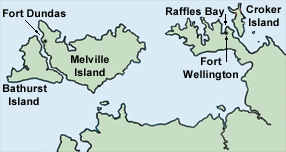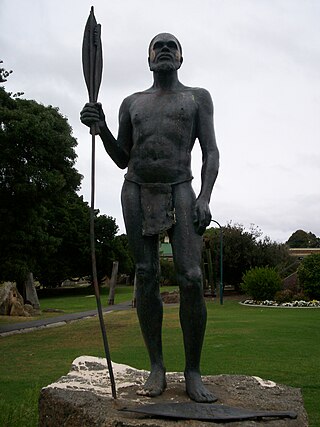
John Septimus Roe was the first Surveyor-General of Western Australia. He was a renowned explorer, a member of Western Australia's legislative and executive councils for nearly 40 years, but also a participant in the Pinjarra massacre on 28 October 1834.

Melville Island is an island in the eastern Timor Sea, off the coast of the Northern Territory, Australia. Along with Bathurst Island and nine smaller uninhabited islands, it forms part of the group known as the Tiwi Islands, which are under the jurisdiction of the Northern Territory in association with the Tiwi Land Council as the regional authority.
Collet Barker was a British military officer and explorer. He explored areas of South Australia, Western Australia and Cobourg Peninsula, Northern Territory.

The Cobourg Peninsula is located 350 kilometres (217 mi) east of Darwin in the Northern Territory, Australia. It is deeply indented with coves and bays, covers a land area of about 2,100 square kilometres (811 sq mi), and is virtually uninhabited with a population ranging from about 20 to 30 in five family outstations, but without any notable settlement or village. It is separated from Croker Island in the east by Bowen Strait, which is 2.5 kilometres wide in the south and up to 7 kilometres in the north, and 8.5 kilometres long. In the west, it is separated from Melville Island by Dundas Strait. From Cape Don, the western point of the peninsula, to Soldier Point in the east of Melville Island, the distance is 28 kilometres (17 mi). In the north is the Arafura Sea, and in the south the Van Diemen Gulf. The highest elevation is Mount Roe in the south with an altitude of 160 metres (525 ft).

Port Essington is an inlet and historic site located on the Cobourg Peninsula in the Garig Gunak Barlu National Park in Australia's Northern Territory. It was the site of an early attempt at British settlement, but now exists only as a remote series of ruins.

Croker Island is an island in the Arafura Sea off the coast of the Northern Territory, Australia, 250 km (160 mi) northeast of Darwin. It was the site of the Croker Island Mission between 1940 and 1968.
The history of the Northern Territory began over 60,000 years ago when Indigenous Australians settled the region. Makassan traders began trading with the indigenous people of the Northern Territory for trepang from at least the 18th century onwards.

Thomas Braidwood Wilson FRGS was an Australian surgeon and explorer. He was baptised in Kirknewton, West Lothian, Scotland, the son of James, and Catherine Boak.
The following lists events that happened during 1827 in Australia.

Fort Dundas was a short-lived British settlement on Melville Island between 1824 and 1828 in what is now the Northern Territory of Australia. It was the first of four British settlement attempts in northern Australia before Goyder's survey and establishment of Palmerston, now known as Darwin. The three later attempts were at Fort Wellington, Port Essington and Escape Cliffs.

Mokare was a Noongar Aboriginal man from the south-west corner of Australia, who was pivotal in aiding European exploration of the area.

Fort Wellington was the name of a short-lived British settlement established in 1827 at Raffles Bay, on the northern side of the Cobourg Peninsula of what is now the Northern Territory of Australia, which was abandoned in 1829. It was the second of a series of four such abortive settlement attempts in Australia's Top End, the first being Fort Dundas (1824–1828) on Melville Island, the third Fort Victoria or Victoria Settlement, at Port Essington (1838–1849) on the Cobourg Peninsula, and the fourth at Escape Cliffs (1864–1867) near the mouth of the Adelaide River.

Escape Cliffs is a place on the northern coast of the Northern Territory of Australia, on the western coast of the Cape Hotham peninsula, and the eastern shore of Adam Bay, near the mouth and estuary of the Adelaide River. It lies about 60 km north-east of Darwin and is located in the Cape Hotham sector of the Djukbinj National Park. It was named by John Lort Stokes of HMS Beagle after visiting the spot in 1840, and refers to an incident where he and Lieut. Helpman escaped with their lives after being attacked by hostile Aboriginal men.
The Croker Group is a group of islands in the Arafura Sea. The group lies offshore from Cobourg Peninsula, and is part of the Northern Territory of Australia. The group is Aboriginal freehold land, held by the Arnhem Land Aboriginal Land Trust.

Mildirn, sometimes spelt Medlone, also known as Jack Davis, Old Jack Davis or Port Essington Jack was a well-known Aboriginal leader, translator and advisor for Port Essington, a site of early British settlement in the Northern Territory of Australia.
The Jaako (Yaako) were an indigenous Australian people of the Northern Territory.
The Oitbi were an indigenous Australian people of the Cobourg Peninsula of the Northern Territory.
The Iwaidja are an indigenous Australian people of the Northern Territory.

From the late 1700s until the end of the 19th century, the British Empire established, expanded and maintained a number of colonies on the continent of Australia. These colonies included New South Wales, Van Diemen's Land, Western Australia, South Australia, Victoria and Queensland. Many of these were initially formed as penal settlements, and all were built on land occupied by Indigenous Australians. In order to keep the large number of transported convicts under control, enforce colonial law and fight the Australian frontier wars, British military elements, including the British Army, were deployed and garrisoned in Australia. From 1790 to 1870 over 30 different regiments of the British Army consisting of a combined total of around 20,000 soldiers were based in the Australian British colonies.
Yalangbara is a coastal area in the East Arnhem (Miwatj) region of Australia's Northern Territory, around 35 km (22 mi) south of Nhulunbuy, the largest town in the area. It is on the country of the Rirratjingu clan of the Yolŋu people, and is one of the most significant cultural areas for the Yolŋu because of its role in the creation story of the Rirratjingu clan, based on the Djang'kawu ancestors.











